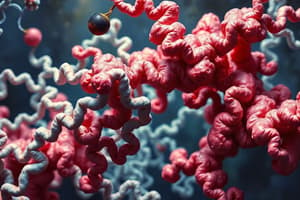Podcast
Questions and Answers
What can cause proteins to unfold by exposing hidden hydrophobic residues?
What can cause proteins to unfold by exposing hidden hydrophobic residues?
- Raising pH to high levels
- Mercato ethanol (correct)
- Observing the effects of pH
- Temperature change
What affects protein stability and folding by observing the effects of temperature, pH, and other factors?
What affects protein stability and folding by observing the effects of temperature, pH, and other factors?
- Fibrous proteins
- Organic solvents
- Temperature and pH (correct)
- Quaternary structure
What is the first step in the protein folding process?
What is the first step in the protein folding process?
- Tertiary structure interactions
- Formation of motifs and domains
- Raising pH to high levels
- Secondary structure formation (correct)
What can denature proteins, allowing refolding to prove sequence determines folding?
What can denature proteins, allowing refolding to prove sequence determines folding?
What can cause amino acids to lose their positive charge, affecting protein structure?
What can cause amino acids to lose their positive charge, affecting protein structure?
What is the primary structure of a protein?
What is the primary structure of a protein?
Which interaction is the most important force driving proteins into a folded state?
Which interaction is the most important force driving proteins into a folded state?
What type of amino acids are strong helix formers?
What type of amino acids are strong helix formers?
What is the rigid and planar bond allowing for hydrogen bonding in proteins?
What is the rigid and planar bond allowing for hydrogen bonding in proteins?
What is the tertiary structure of a protein primarily stabilized by?
What is the tertiary structure of a protein primarily stabilized by?
What are the disadvantages of gene identification and discovery in prokaryotes?
What are the disadvantages of gene identification and discovery in prokaryotes?
What are the different approaches used for gene finding in prokaryotes?
What are the different approaches used for gene finding in prokaryotes?
What are the advantages of gene structure in prokaryotes?
What are the advantages of gene structure in prokaryotes?
Flashcards are hidden until you start studying
Study Notes
- In Chapter 4, the focus shifts to the structure, function, and folding of proteins.
- Proteins are structured in various ways: primary (sequence of amino acids), secondary (alpha helix, beta sheet, etc.), tertiary (overall protein shape), and sometimes quaternary (multiple polypeptide chains).
- The protein's sequence determines its three-dimensional structure.
- Protein structure is crucial to its function.
- Proteins exist in a favorable conformation.
- Non-covalent interactions like hydrophobic effect and hydrogen bonds play a significant role in protein folding.
- Common patterns are observed in protein structures.
- Protein structures can change.
- Peptide bond is rigid and planar, allowing for hydrogen bonding between amide nitrogens and carboxylic acid nitrogens.
- The hydrophobic effect is the most important interaction driving proteins into a folded state.
- Hydrogen bonds are the second important force driving proteins into a folded state.
- The tertiary structure optimizes hydrophobic interactions and maximizes hydrogen bonding.
- Alanine and leucine are strong helix formers, while proline and glycine are helix breakers.
- Beta sheets have side chains poking out in opposite directions, forming anti-parallel or parallel structures.
- The tertiary structure stabilizes the protein by weak interactions, allowing the alpha helices and beta sheets to interact.
- Fibrous proteins like keratin, collagen, and elastin are strong and flexible.
- Hemoglobin is a well-studied example of a protein with a quaternary structure.
- Protein stability and folding are studied by observing the effects of temperature, pH, and other factors.
- Heat or cold can affect hydrogen bonding.
- Proteins unfold at their melting temperature.- Raising pH to high levels (11 or 12) causes amino acids to lose their positive charge, affecting protein structure.
- Organic solvents can cause proteins to unfold by exposing hidden hydrophobic residues.
- Urea and mercato ethanol can denature proteins, allowing refolding to prove sequence determines folding.
- Protein folding process starts with secondary structure formation, followed by tertiary structure interactions.
- Hydrophobic interactions stabilize tertiary structures, and motifs and domains form last.
- Incorrectly folded proteins can clump together and lead to diseases, such as Alzheimer's and its associated amyloid protein.
Studying That Suits You
Use AI to generate personalized quizzes and flashcards to suit your learning preferences.


